FRENCH LETTER
Olives and the art of l’apéro
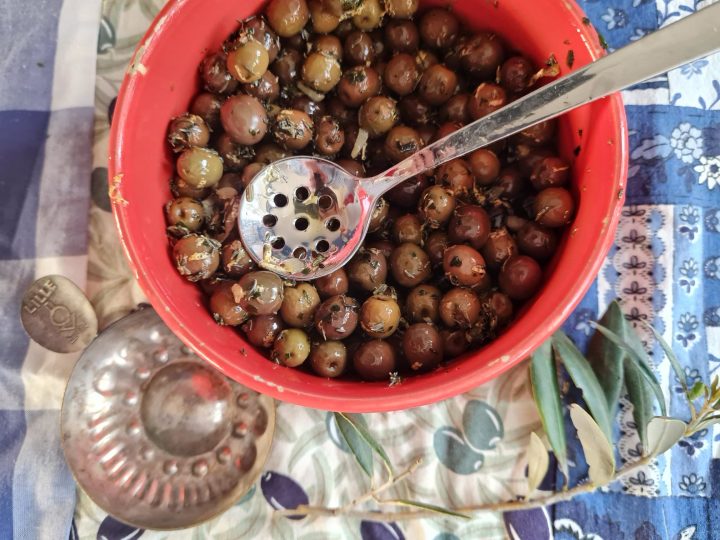
Spring is springing and the birds are singing and the wisteria hangs in a purple haze in the back yard – a sure sign that we can start enjoying aperitifs outside under our olive tree again.
The author supports Isabelo, chef Margot Janse’s charity which feeds school children every day. Please support them here.
The olive tree is one of the reasons we fell in love with a dilapidated old farmhouse that had been uninhabited for quite a few years when we first laid eyes on it. The house was far from perfect, with damp walls and peeling wallpaper, cracked window panes, faulty plumbing and inadequate electricity. There was no garden, only an ugly tarred front court overgrown with weeds.
We realised it would take a lot of tender loving care (and elbow grease) to turn this place into the home we wanted. But it had potential (and we couldn’t afford anything else) and when I opened the kitchen door and saw the neglected olive tree’s leaves glittering like silver in the late afternoon sun, I had a vision of all the memorable meals we would share with family and friends in the shade of that legendary tree.
Yes, legendary, because long before we had our own olive tree, I knew that these trees and their branches had been regarded as symbols of peace, wisdom, light, purity and other desirable states – even immortality – since ancient times.
Or as Pliny the Elder said in the first century AD: Except the vine, there is no plant which bears a fruit of as great importance as the olive.
So it seemed entirely appropriate that our new home, surrounded by vineyards, should also offer us the fruit – and the blessed shade – of an olive tree.

The original olive tree in our back yard. (Photo: Marita van der Vyver)
A decade later I can indeed look back on countless delightful lunches and dinners and breakfasts and brunches under our olive tree.
It quickly became clear, though, that the round wooden table under the tree would be too small, even for simple family meals, as our children started growing up and bringing their friends and their partners home. We acquired a long wooden table with a dozen chairs to place on the far side of the tree, next to the wisteria that we’d planted ourselves and that was slowly but surely beginning to provide shade in that part of the back yard. But we kept the smaller table under the olive tree for more intimate meals – and, above all, for the honourable French tradition of l’apéro.
Because over here, when you invite guests for a meal, you can’t simply dump them at the dinner table and start serving the food. Neither can you expect them to stand around with a glass of wine and nibble on some peanuts, like you might do in South Africa, until dinner is brought to the table.
Non, non, non.
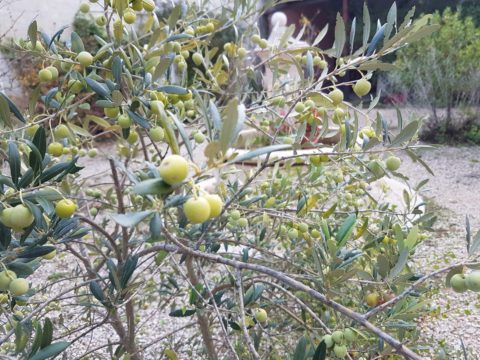
One of the small trees we planted. (Photo: Marita van der Vyver)
L’apéro, or the aperitif, is a sit-down affair, an essential part of the whole ritual of a proper French meal, a particular art form that was listed as an Intangible Cultural Heritage of Humanity by Unesco some years ago. A decent meal in France consists not only of a starter, a main course, a couple of cheeses (served before dessert) and something sweet at the end; it also needs an apéro like a musical needs an overture.
It’s a case of starting at the very beginning, as Julie Andrews sang in The Sound of Music, and an aperitif is always a very good place to start. It gets even better if you can enjoy the aperitif under an olive tree. After all, olive groves are an integral part of the landscape of Provence, and the small green and black fruits of these trees have become an almost indispensable ingredient of a good apéro around here.
Although olives are harvested in winter, they can’t be eaten directly from the tree, and they achieve their finest hour around apéro tables in spring and summer. This happens after they have been pickled and preserved for weeks or even months in fragrant, spicy, herby brines. And when these pickled olives come from the very tree under which you and your guests are now nibbling on them, well, it inevitably turns an ordinary apéro into a special occasion.
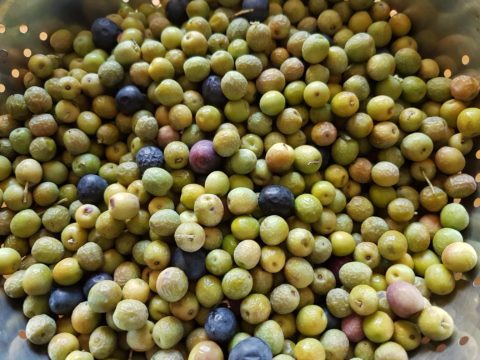
Last winter’s olive harvest. (Photo: Marita van der Vyver)
Of course we don’t have to pickle our own olives – even though we planted four more trees, some years the harvest is still so meagre and we are so lazy that it doesn’t seem worth the effort – because we can buy the most delicious olives at any local morning market. The choice is huge, and often confusing, between small black olives with wrinkled skin and garlic flavours, or fancy green ones stuffed with almonds, slivers of anchovy or red pepper, or smooth and shiny Greek-style olives, or…
Or we can simply buy a selection to taste them all. Which is usually what we do.
But even in the years when the olives we preserve from our own trees turn out too bitter or too salty, and the ones we can get at the village market seem much more tempting, we can still use our modest harvest to make tapenade. It is an excruciatingly boring task to get rid of the pips, especially if the olives are rather small, before you can crush them and add the anchovies, capers and garlic to produce the delectable green or black spread known as tapenade. It is frankly much easier to go and buy tapenade at the nearest market.
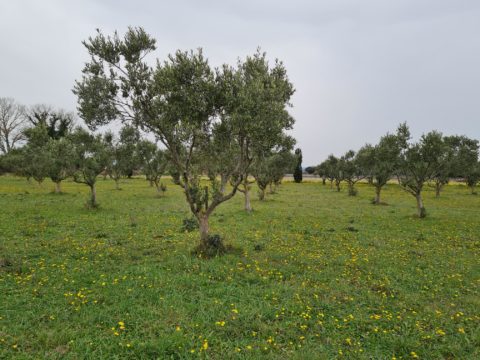
A neighbour’s olive grove in spring. (Photo: Marita van der Vyver)
But hey, I’m a recovering Calvinist, raised with the motto “Waste not, want not”, so I would never dream of throwing away our precious olives simply because they don’t taste quite as good as those offered at the market.
Non, non, non.
I would rather make tapenade. I once made tapenade for more than 60 guests at a big birthday party celebrated at our home – and the fact that at least some of the olives in the tapenade came from the tree in our back yard thrilled me much more than offering a guest any of the books I had written (see below).
In this seemingly never-ending Covid season, we might not be sharing our olives or our tapenade with many guests. As the third wave washes over France, we’re back in virtual house arrest for a few weeks, once again not allowed to move more than 10 km from our homes, and only at certain hours. And we are still not allowed to share a meal with more than six adults around a table – a rule we’ve been forced to follow for almost six months now.
But last weekend, for the first time after the long dark winter, we enjoyed our apéro under the olive tree again. A modest little aperitif it was, just me and my partner and our daughter sharing a bowl of our own preserved olives, from our own tree, with chunks of fresh baguette on which we dripped some excellent olive oil.
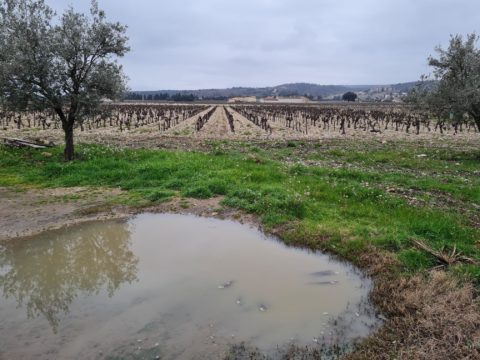
Bare wintry vineyards near our home. (Photo: Marita van der Vyver)
The oil was not from our tree, but from the Domaine Gerbaud near Lourmarin, belonging to South African friends. And the wine was a pale rosé from Château de Valcombe near Nîmes, which belongs to the family of a French-South African couple we know.
I suppose you could call it a way of being with friends when you can’t physically be with them?
It was a comforting thought, anyway, as I lifted my glass to toast absent guests.

Part of our very own olive harvest. (Photo: Marita van der Vyver)
Until we can invite friends and family again for boisterous gatherings around the long table in the back yard, we’ll continue the tradition of apéros under the olive tree in a more subdued way.
Besides, what else do we do with all the preserved olives from last winter’s harvest? DM/TGIFood
Our tapenade recipe can be found in my book Winter Food in Provence (Tafelberg, 2014)






 Become an Insider
Become an Insider
Comments - Please login in order to comment.